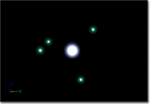Phonon
In quantum physics, a phonon is the discrete quantum particle which carries sound. Since everything else in the friggin' universe is quantized, such as light, electric charge, angular momentum, speed, time, and money, it was inevitable that the wave-like nature of sound waves would also be found to have its own particle aspect.
Waviness of sound waves[edit | edit source]
The wave-like nature of sound waves has been previously known by physicists for many thousands of years. Prehistoric guitar strings which have been preserved in prehistoric amber lamps clearly show their residual wavy shapes, having died in mid-vibration. The indirect effects of the erotic curvyosity of sound were also apparent in the spiraling-patterns of spiral galaxies and the lemming-like behaviors of televised sporting-event crowds.
In 1603, Johannes Kepler constructed a musical instrument made entirely of rubber bands and corrugated cardboard and Elmer's glue and sparkly sprinkles which successfully simulated the musical cacophony produced by the Solar System's planetary system of planets. Regretably, it had to be demolished by the Spanish Inquisition because it was too fucking loud.
Discovery of the phonon[edit | edit source]
Nobody knows who first discovered the phonon, so a special Nobel Prize in Acoustics is currently being held in an underground storage tank, pending the discovery of the discoverer, or whoever finally fesses up (whichever occurs first). Phonons were later discovered to be emanating from all known forms of musical instruments, with the sole exception of the samovar (a Russian stringed instrument which doesn't register on even the most sensitive phonon detectors or geiger counters).
Natural sources of phonons are few and far in between. As of 2026 January 8 04:52, the only known extraterrestrial emitter of all-natural phonons is the Sun itself. NASA is currently looking into sending a solar spaceprobe (provisionally dubbed SolarGraph 1™) to detect stray phonons with their patented stray phonon detector: a technologically-advanced platinum-iridium needle which traces a wavy line into a wax-covered polymer substrate.
Oversimplified mathematical model of the phonon[edit | edit source]
The underlying advanced mathematics of quantum acoustics were given their final form by Erwin Schrödinger's cat two years before the unfortunate feline was found murdered at the hands of her enraged owner in approximately half of the alternative timelines of the multiverse. Fortunately for those of you who do not fully understand quantum mechanics, a simplified and semi-comprehensible mathematical representation of the phonon is readily available.
The phonon's energy is given by
E = f c2 h
where E is energy (in units of kilocalories), f is frequency (in units of disco beats per minute), c2 is the speed of light squared (which is really, really fast), and h is Planck's constant (a fudge factor of sorts). The typical upshot is that the equivalent energy of even the most feeble phonon is so mind-boggingly huge that it makes the typical normal person reading this dumbass most excellent Uncyclopedia entry go "Huh?" in mild confusion.
Deadly phononic radiation[edit | edit source]
Unshielded exposure to phonon-emitting devices are generally not known to be particularly dangerous to living tissue or other human organs. Even so, the US Occupational Safety and Health Administration and the US Food and Drug Administration have both issued dire warnings of doom and gloom concerning external contact with and/or internal ingestion of unregistered speaker phones and/or cheap imported iPods. Fortunately, the incoming president-elect Donald Trump has vowed to do away with all inconvenient Federal regulatory agencies, so please feel free to continue to bathe yourselves in the warm cozy comfort of those flashy phonon-saturated night clubs. See if I care.


